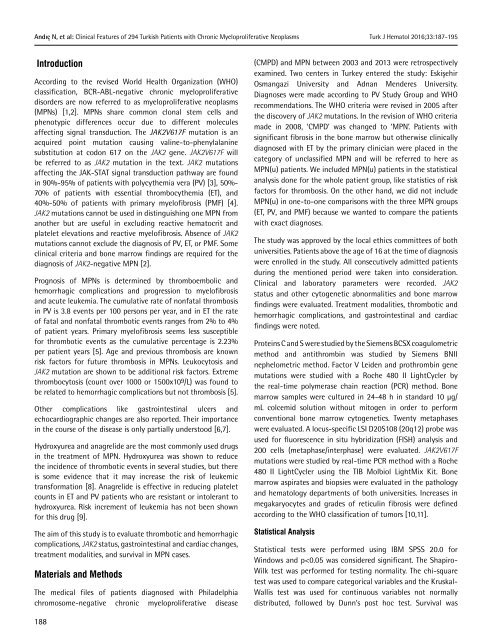Turkish Journal of Hematology Volume: 33 - Issue: 3
Create successful ePaper yourself
Turn your PDF publications into a flip-book with our unique Google optimized e-Paper software.
Andıç N, et al: Clinical Features <strong>of</strong> 294 <strong>Turkish</strong> Patients with Chronic Myeloproliferative Neoplasms Turk J Hematol 2016;<strong>33</strong>:187-195<br />
Introduction<br />
According to the revised World Health Organization (WHO)<br />
classification, BCR-ABL-negative chronic myeloproliferative<br />
disorders are now referred to as myeloproliferative neoplasms<br />
(MPNs) [1,2]. MPNs share common clonal stem cells and<br />
phenotypic differences occur due to different molecules<br />
affecting signal transduction. The JAK2V617F mutation is an<br />
acquired point mutation causing valine-to-phenylalanine<br />
substitution at codon 617 on the JAK2 gene. JAK2V617F will<br />
be referred to as JAK2 mutation in the text. JAK2 mutations<br />
affecting the JAK-STAT signal transduction pathway are found<br />
in 90%-95% <strong>of</strong> patients with polycythemia vera (PV) [3], 50%-<br />
70% <strong>of</strong> patients with essential thrombocythemia (ET), and<br />
40%-50% <strong>of</strong> patients with primary myel<strong>of</strong>ibrosis (PMF) [4].<br />
JAK2 mutations cannot be used in distinguishing one MPN from<br />
another but are useful in excluding reactive hematocrit and<br />
platelet elevations and reactive myel<strong>of</strong>ibrosis. Absence <strong>of</strong> JAK2<br />
mutations cannot exclude the diagnosis <strong>of</strong> PV, ET, or PMF. Some<br />
clinical criteria and bone marrow findings are required for the<br />
diagnosis <strong>of</strong> JAK2-negative MPN [2].<br />
Prognosis <strong>of</strong> MPNs is determined by thromboembolic and<br />
hemorrhagic complications and progression to myel<strong>of</strong>ibrosis<br />
and acute leukemia. The cumulative rate <strong>of</strong> nonfatal thrombosis<br />
in PV is 3.8 events per 100 persons per year, and in ET the rate<br />
<strong>of</strong> fatal and nonfatal thrombotic events ranges from 2% to 4%<br />
<strong>of</strong> patient years. Primary myel<strong>of</strong>ibrosis seems less susceptible<br />
for thrombotic events as the cumulative percentage is 2.23%<br />
per patient years [5]. Age and previous thrombosis are known<br />
risk factors for future thrombosis in MPNs. Leukocytosis and<br />
JAK2 mutation are shown to be additional risk factors. Extreme<br />
thrombocytosis (count over 1000 or 1500x109/L) was found to<br />
be related to hemorrhagic complications but not thrombosis [5].<br />
Other complications like gastrointestinal ulcers and<br />
echocardiographic changes are also reported. Their importance<br />
in the course <strong>of</strong> the disease is only partially understood [6,7].<br />
Hydroxyurea and anagrelide are the most commonly used drugs<br />
in the treatment <strong>of</strong> MPN. Hydroxyurea was shown to reduce<br />
the incidence <strong>of</strong> thrombotic events in several studies, but there<br />
is some evidence that it may increase the risk <strong>of</strong> leukemic<br />
transformation [8]. Anagrelide is effective in reducing platelet<br />
counts in ET and PV patients who are resistant or intolerant to<br />
hydroxyurea. Risk increment <strong>of</strong> leukemia has not been shown<br />
for this drug [9].<br />
The aim <strong>of</strong> this study is to evaluate thrombotic and hemorrhagic<br />
complications, JAK2 status, gastrointestinal and cardiac changes,<br />
treatment modalities, and survival in MPN cases.<br />
Materials and Methods<br />
The medical files <strong>of</strong> patients diagnosed with Philadelphia<br />
chromosome-negative chronic myeloproliferative disease<br />
(CMPD) and MPN between 2003 and 2013 were retrospectively<br />
examined. Two centers in Turkey entered the study: Eskişehir<br />
Osmangazi University and Adnan Menderes University.<br />
Diagnoses were made according to PV Study Group and WHO<br />
recommendations. The WHO criteria were revised in 2005 after<br />
the discovery <strong>of</strong> JAK2 mutations. In the revision <strong>of</strong> WHO criteria<br />
made in 2008, ‘CMPD’ was changed to ‘MPN’. Patients with<br />
significant fibrosis in the bone marrow but otherwise clinically<br />
diagnosed with ET by the primary clinician were placed in the<br />
category <strong>of</strong> unclassified MPN and will be referred to here as<br />
MPN(u) patients. We included MPN(u) patients in the statistical<br />
analysis done for the whole patient group, like statistics <strong>of</strong> risk<br />
factors for thrombosis. On the other hand, we did not include<br />
MPN(u) in one-to-one comparisons with the three MPN groups<br />
(ET, PV, and PMF) because we wanted to compare the patients<br />
with exact diagnoses.<br />
The study was approved by the local ethics committees <strong>of</strong> both<br />
universities. Patients above the age <strong>of</strong> 16 at the time <strong>of</strong> diagnosis<br />
were enrolled in the study. All consecutively admitted patients<br />
during the mentioned period were taken into consideration.<br />
Clinical and laboratory parameters were recorded. JAK2<br />
status and other cytogenetic abnormalities and bone marrow<br />
findings were evaluated. Treatment modalities, thrombotic and<br />
hemorrhagic complications, and gastrointestinal and cardiac<br />
findings were noted.<br />
Proteins C and S were studied by the Siemens BCSX coagulometric<br />
method and antithrombin was studied by Siemens BNII<br />
nephelometric method. Factor V Leiden and prothrombin gene<br />
mutations were studied with a Roche 480 II LightCycler by<br />
the real-time polymerase chain reaction (PCR) method. Bone<br />
marrow samples were cultured in 24-48 h in standard 10 µg/<br />
mL colcemid solution without mitogen in order to perform<br />
conventional bone marrow cytogenetics. Twenty metaphases<br />
were evaluated. A locus-specific LSI D20S108 (20q12) probe was<br />
used for fluorescence in situ hybridization (FISH) analysis and<br />
200 cells (metaphase/interphase) were evaluated. JAK2V617F<br />
mutations were studied by real-time PCR method with a Roche<br />
480 II LightCycler using the TIB Molbiol LightMix Kit. Bone<br />
marrow aspirates and biopsies were evaluated in the pathology<br />
and hematology departments <strong>of</strong> both universities. Increases in<br />
megakaryocytes and grades <strong>of</strong> reticulin fibrosis were defined<br />
according to the WHO classification <strong>of</strong> tumors [10,11].<br />
Statistical Analysis<br />
Statistical tests were performed using IBM SPSS 20.0 for<br />
Windows and p

















